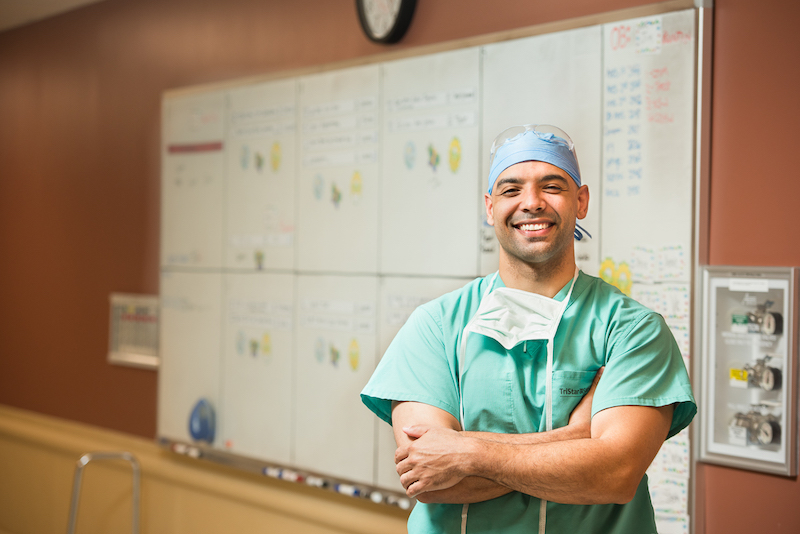TSC Rutherford
515 StoneCrest Pkwy | Suite 230
Smyrna, TN 37167
TEL 615.223.9935 FAX 615.891.5046
Scarless Thyroid Surgery
Are you facing the prospect of thyroid surgery but are concerned about the visible scars it may leave? We understand your apprehensions, and that’s why we proudly offer state-of-the-art scarless thyroid and parathyroid surgery in the greater Nashville area.
Keep reading to learn more about the thyroid, thyroid surgery, how you may benefit from scarless surgery, and more.
What is a thyroid?
The thyroid is a butterfly-shaped gland located at the base of the neck, just below the Adam’s apple. Its primary function is to produce thyroid hormones—mainly thyroxine (T4) and triiodothyronine (T3). These hormones play a vital role in regulating metabolism, aiding growth and development, regulating body temperature, controlling the body’s energy production and consumption, and influencing other physiological processes.
Thyroid Problems That May Require Surgery
Problems with the thyroid gland can lead to various conditions, including hypothyroidism (insufficient production of thyroid hormones) and hyperthyroidism (excessive production of thyroid hormones). Common thyroid disorders include Hashimoto’s thyroiditis, Graves’ disease, thyroid nodules, and thyroid cancer. If conservative treatments are ineffective, a doctor may recommend thyroid surgery to remove part or all of the thyroid.
Solving The Concern Over Thyroid Surgery Scars
Traditionally, thyroid surgery has involved making a horizontal incision across the neck, just below the Adam’s apple. While effective, this method often leaves visible scars on the neck, causing understandable concerns for patients.
However, in the era of modern medicine, we have embraced innovative techniques to provide scarless transoral endocrine surgery (TES) as an option for thyroid and parathyroid procedures. This groundbreaking approach allows our skilled surgeons to operate on these glands through tiny incisions in the mouth, utilizing advanced endoscopic instruments. The result? No external scars on your neck, making scarless thyroid surgery a preferred choice among patients.
Types of Scarless Thyroid Surgery
Scarless transoral endocrine surgery encompasses various procedures designed to address specific thyroid and parathyroid conditions:
→ Total Thyroidectomy: In this comprehensive procedure, the entire thyroid gland is removed. It is typically recommended for cases where complete removal is necessary.
→ Partial Thyroidectomy: Partial thyroidectomy involves removing a portion of the thyroid gland. It is often chosen to address thyroid tumors or treat hyperthyroidism.
→ Parathyroidectomy: This surgical intervention targets one or more of the parathyroid glands located in the neck. These glands play a crucial role in regulating calcium levels in the body.
→ Thyroid Lobectomy: A thyroid lobectomy involves the removal of one of the thyroid gland’s two lobes. It’s a suitable choice for specific thyroid conditions.
Safety and Effectiveness of Transoral Thyroid Surgery
How safe and effective is transoral thyroid surgery? Dr. Joshua Taylor, a leading authority in this field, notes that this surgical technique was introduced in the United States in 2015. Johns Hopkins in Maryland currently performs the highest volume of transoral endocrine surgery in the country.
Rest assured, transoral thyroid and parathyroid surgery is gaining recognition and acceptance nationwide due to its safety and effectiveness. Our experienced team at TSC Rutherford is dedicated to providing you with a trusted, minimally invasive, and scarless thyroid surgery option.
Don’t let concerns about scarring hold you back from the thyroid surgery you need. Contact us today if you are looking for thyroid surgery in Nashville, like scarless thyroid and parathyroid surgery, and embark on your journey to improved health with confidence.
Thyroid Surgery Without neck Scars
Transoral thyroid surgery is performed through the lip and is essentially performed the same as traditional surgery – without leaving a scar.
We can remove one side of the thyroid or both sides of a total thyroid. We can also remove some of the lymph nodes that live in the lower neck, if that’s necessary. In addition, we can perform parathyroid surgeries. Parathyroid glands are the little small glands that live behind the thyroid that are sometimes affected during surgery – these can also we removed through this transoral (through the lip) approach.
Watch an animation of scarless thyroid surgery.
Thyroid Surgeon
Who performs scarless thyroid surgery?
Dr. Joshua Taylor is the only surgeon at The Surgical Clinic to perform this surgery in Smyrna, right outside Nashville, Tennessee. He attended a medical training course at Johns Hopkins where he focused on this procedure. As an experienced thyroid surgeon, he specializes in robotic & minimally invasive treatments of the thyroid, like RF Ablation of the thyroid/parathyroid nodules.
HOW IS SCARLESS THYROID SURGERY PERFORMED?
Transoral thyroid surgery is performed through the lip and is essentially performed the same as traditional surgery – without leaving a scar.
We can remove one side of the thyroid or both sides of a total thyroid. We can also remove some of the lymph nodes that live in the lower neck, if that’s necessary. In addition, we can perform parathyroid surgeries. Parathyroid glands are the little small glands that live behind the thyroid that are sometimes affected during surgery – these can also we removed through this transoral (through the lip) approach.
Conditions Treated with Thyroid Surgery
Transoral Thyroid Surgery (Scarless Thyroidectomy)
With the scarless thyroidectomy, we are able to treat all types of endocrine disease relating to the thyroid and parathyroid glands. A doctor may recommend thyroid surgery for various thyroid problems when conservative treatments are ineffective. As mentioned, if the nearby lymph nodes in the neck and around the thyroid need to be removed, we can remove them during this procedure.
Some conditions thyroid surgery may treat include:
1. Thyroid Cancer
Surgery is an effective treatment to remove cancerous tissue if a thyroid nodule is malignant. The surgery may remove a portion of the thyroid (partial thyroidectomy) or the entire thyroid gland (total thyroidectomy), depending on the extent of the cancer.
2. Large or Growing Thyroid Nodules
Surgery may be needed to remove enlarged thyroid nodules, especially those causing compression or difficulty swallowing. This treatment is recommended if the nodules are causing symptoms or may be cancerous.
3. Hyperthyroidism (Overactive Thyroid)
In cases of hyperthyroidism that do not respond well to medications or radioactive iodine treatment, surgical removal of a portion of the thyroid (subtotal or near-total thyroidectomy) may be recommended to regulate thyroid hormone levels.
4. Goiter (Enlarged Thyroid)
A goiter is an enlarged thyroid gland that various conditions, including iodine deficiency or autoimmune thyroid disorders, can cause. Someone may opt for surgery if a goiter is causing compression of nearby structures or is cosmetically problematic.
5. Thyroid Nodules with Indeterminate or Suspicious Biopsy Results
If a fine-needle aspiration (FNA) biopsy of a thyroid nodule yields indeterminate or suspicious results, surgery may be recommended for a more accurate diagnosis and to rule out cancer.
6. Recurrent Thyroid Cysts
Thyroid cysts that recur or cause persistent symptoms may be treated with surgery to remove the cyst and, if necessary, a portion of the thyroid gland.
7. Thyroiditis
In cases of chronic thyroid inflammation, surgery may be considered if the inflammation causes persistent symptoms or if there is a risk of complications.
During Thyroid Surgery
Transoral Thyroid Surgery
Once the patient is sedated, Transoral (Scarless) Thyroid Surgery begins with making three incisions behind the lip where surgical access ports are placed. Next, surgeons use a special pillow to align the patient’s neck while using endoscopic surgical tools to operate on the thyroid gland, parathyroid gland or surrounding lymph nodes.
After the diseased tissue is removed, it is placed in a small pouch and extracted from the neck through the surgical ports. When the surgery is completed, the ports are removed and the incisions will be closed with absorbable sutures.
After Thyroid Surgery
Thyroid Surgery Recovery for Transoral Thyroid Surgery
Patients usually spend the first night after surgery in the hospital for monitoring. Typically, patients are sent home the next day. The sutures will be absorbed into the body within the next few days, and we usually have patients wear a compression garment around their neck to reduce swelling and promote healing.
For the first day after surgery, we place patients on a liquid diet, and then we have them introduce soft foods the next day. After about three days, patients should be able to start reintroducing solid foods.
It is important that patients keep their mouths especially clean for the first few days after surgery. We recommend that patients rinse with an antiseptic mouthwash after eating to ensure the incisions do not become infected.
Thyroid Surgery Risks
What are the risks of Scarless Thyroid Surgery?
The risks are similar to the risks of traditional thyroid and parathyroid surgery. The instructions for your recovery can prevent many of these risks, but others may be related to your medical history. When you consult with your surgery, make sure to thoroughly review you and your family’s health history in order to mitigate your risks.
The risks of thyroid surgery Include:
Infection, Swelling, Nerve Damage, Voice Hoarseness, Temporary,Voice Change, Breathing Problems from Anesthesia, Changes in Blood Pressure

